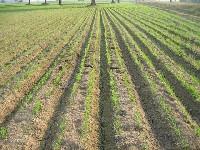Labour-saving technologies and practices: raised beds
The following includes the features of raised bed cultivation from a practical perspective, including tips and recommendations. Advantages include labour-saving, livelihood resilience strengthening, equipment and risk. Disadvantages include labour, skills and technical limitations.
Description
Repeated tilling of the soil to the same depth, either by hand or draught animal, causes plough pans which result in poor plant growth. Lots of human and animal traffic on the cultivated fields causes soil compaction.
1. Features of raised bed cultivation
- Crops are grown in raised beds (1.20 m wide and about 20 cm deep) with 60 cm wide paths between them for human and animal traffic.
- The beds are constructed along the contour to minimize any water flow down the paths during high rainfall. If the land is uneven, the beds are constructed slightly off-contour to prevent possible ponding and overflow going across the beds and causing erosion.
- Before the beds are formed all perennial weeds are killed with a spray of Glyphosate (Round-up) with a carrier of 0.5 percent urea. It may be necessary to rip the hardpan if the soil is compacted.
- The land is ploughed or dug and the tilth developed before the beds are made. Short beds are formed by hand and longer beds by draught animals (with ridgers) or tractor.
- Two or three rows of the crop are sown per bed depending on the crop.
- The beds remain from season to season and require regular maintenance.
- Once the beds are established and planted, they are either mulched or cover crops are grown to suppress the weeds and improve soil quality.
- The mulch has to be topped up regularly, normally after each planting, sometimes between plantings (up to four times per year). Care should be taken not to include weed seeds or diseases in this mulch.
- Subsequent crops are planted through the mulch or cover crop.
- Beds should be installed with full conservation works, including contours and grassed waterways due to the possible concentration of runoff in the rows between the beds.
2. Advantages
2.1 Labour saving
There is a reduction in labour requirements for cultivation and weed control once the beds are established and cover crop/mulch in place. Less bending over to tend the crop.
2.2 Livelihood resilience strengthening
The beds provide a medium for intensive crop production and improve yields per unit of labour input. Soil compaction is reduced and build up of organic matter in the soil from mulches leads to improved soil structure (which in turn increases water infiltration, reduces soil erosion and improves soil fertility). Better disease control because beds can be isolated. The increase in production and the higher resistance to extreme weather events such as drought and heavy rainfall contribute to enhance resilience.
2.3 Equipment
There are no special requirements to use the equipment. Draught animals and tractors may be used, if available, to help with bed construction.
2.4 Risk
To minimize risk and gain from experience, farmers starting with raised beds should only put a part of their land under the system initially.
3. Disadvantages
3.1 Labour
High labour and work input is required in the first year to landform and establish beds.
3.2 Skills
Training is required in bed construction and maintenance.
3.3 Technical limitations
This practice is not suitable for uneven land as paths concentrate rainfall in depressions and flood across the beds. Generally, it is unsuitable for lands grazed during the winter periods as compaction will occur in the beds, and they will have to be reformed each year. It is dependent on mulch material to prevent beds from eroding away.
Figure 1. Raised beds

©FAO/TECA
4. Related/associated technologies
- Labour-saving technologies and practices: conservation agriculture: ID 7294.
- Labour-saving technologies and practices: improved hand tools for harvesting cereals: 7295.
- Labour-saving technologies and practices: fuel-efficient stoves: ID 7297.
- Labour-saving technologies and practices: integrated pest management: ID 7298.
- Labour-saving technologies and practices: improved use of hoes for land preparation, planting and weeding: ID 7300.
- Labour-saving technologies and practices: row planting, hand seeders and planters: ID 7301.
- Labour-saving technologies and practices: seeds and crops: ID 7302.
- Labour-saving technologies and practices: weed wipes and knapsack sprayers: ID 7303.
- Labour-saving technologies and practices: roof water harvesting: ID 7304.
5. Objectives fulfilled by the project
5.1 Labour-saving technology (LST)
The practice allows for less physicality to be used and less labour requirements for cultivation and weed control.
5.2 Resource use efficiency
Improvement in soil quality and pest control.
5.3 Pro-poor technology
The practice is easy to use, increases crop production and improves yields.
